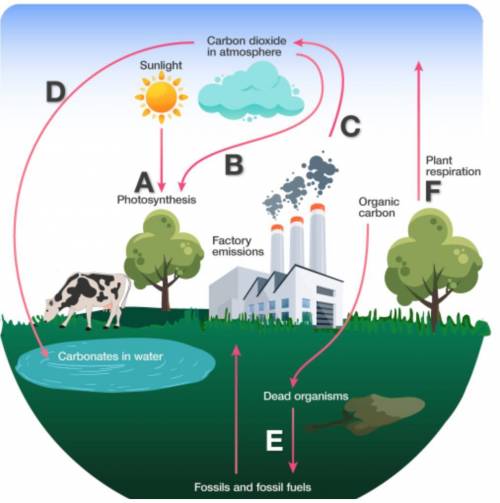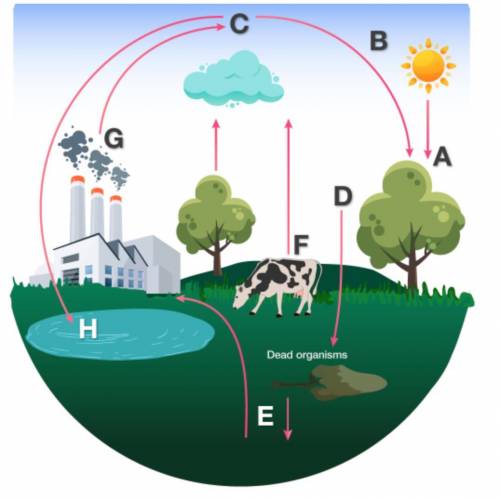
Chemistry, 08.12.2020 18:50 jsharma57p7enrw
The Carbon Cycle Activity Worksheet
Instructions: Answer the questions below using the reference images. You will submit your completed worksheet.
Part One
Text Version
Using the diagram above, match the description to the corresponding location in the carbon cycle model. Provide the letter only.
Carbon dioxide is converted to sugar used for food.
Carbon trapped in fossil fuels is converted to carbon dioxide.
Organic carbon is converted to fossil fuels.
Carbon dioxide is converted to carbonates.
Sugar is broken down and converted to carbon dioxide.
Location _
Location _
Location _
Location _
Location _
Part Two
Text Version
Using the diagram above, answer the following questions:
True or False. The arrow labeled C represents a transfer of chemical energy to mechanical energy. Explain why this is true or false.
True or False. The arrow labeled A represents a transfer of solar energy to chemical energy. Explain why this is true or false.
Which arrow or arrows represent a release of carbon dioxide? What process is occurring at the arrow(s) you selected?
Which arrow or arrows indicate a process that cycles carbon from living or nonliving organisms? Describe the process or processes you selected.
Which arrow or arrows represent reactions that demonstrate a conservation of mass and energy? Explain your answer.



Answers: 1


Another question on Chemistry

Chemistry, 21.06.2019 12:30
What type of scientific model does the flow chart represent? (a chart of the scientific process) a. conceptual b. mathematical c. physical d. virtual
Answers: 1

Chemistry, 21.06.2019 20:30
In a laboratory experiment, a fermenting aqueous solution of glucose and yeast produces carbon dioxide gas and ethanol. the solution was heated by burning natural gas in a bunsen burner to distill the ethanol that formed in the flask. during the distillation, the ethanol evaporated and then condensed in the receiving flask. the flame of the burner was kept too close to the bottom of the flask and some of the glucose decomposed into a black carbon deposit on the inside of the flask. during this experiment the following changes occurred. which of these changes involved a physical change and not a chemical change? check all that apply. 1-condensation of ethanol 2-evaporation of ethanol 3- formation of carbon dioxide gas from glucose burning of natural gas 4-formation of ethanol from glucose by yeast 5-formation of a carbon deposit inside the flask
Answers: 2


Chemistry, 22.06.2019 10:00
Diffraction is when light is bent around obstructions. which of the these observation about clouds would indicate diffraction? a) after rain storms, you can sometimes see rainbows. b) clouds are white or gray and cannot be seen through. c) on a cloudy day, the temperature tends to be cooler than a sunny day. d) the edges of dark clouds appear lighter. this
Answers: 3
You know the right answer?
The Carbon Cycle Activity Worksheet
Instructions: Answer the questions below using the reference im...
Questions

Mathematics, 16.10.2019 22:00

Health, 16.10.2019 22:00













Mathematics, 16.10.2019 22:00



Chemistry, 16.10.2019 22:00




